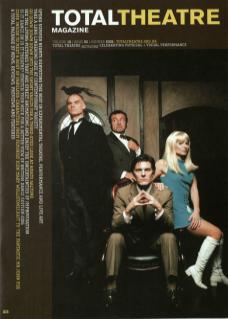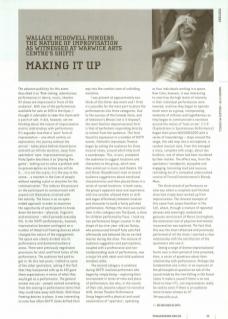The advance publicity for this event described it as 'Risk-taking, adventurous performances in dance, music, theatre. All shows are improvised in front of the audience.’ With one of the performances available for sale on DVD in the foyer, I thought it advisable to take this claim with a pinch of salt. It did, however, set me thinking about the nature of improvisation and its relationships with performance. It's arguably true that a 'pure' form of improvisation – one which centres on exploration, the journey without the arrival – takes place behind closed doors and with an infinite duration, away from spectators' eyes. Improvisational guru Viola Spolin describes it as 'playing the game': 'setting out to solve a problem with no preconception as to how you will do it... it is not the scene, it is the way to the scene... a moment in the lives of people without needing a plot or storyline for the communication.’ This reduces the pressure on the participant to communicate with anyone not themselves involved with the activity. The focus is on an open-ended approach in order to maximise the opportunity for participants to break down the barriers – physical, linguistic and emotional – which pervade everyday life. In the SHIFTI performances, however, improvisation became contingent on a number of theatrical framing devices which changed the nature of the engagement. The space was clearly divided into lit performance and darkened audience areas. There were previously negotiated provisions for start and finish times of the performance. The audience had paid to get in. On this last point, I talked to some of the other spectators, asking if the fact that they had parted with up to £20 gave them expectations in terms of what they would get as a performance. The general answer was yes – people wanted something from the evening in performance terms that they could take away with them. With these framing devices in place, it was interesting to note how often SHIFTI items drifted their way into the comfort zone of unfolding narrative.
I was present at approximately two-thirds of this three-day event and I think it is possible for the most part to place the performances into three categories. Due to the success of the Comedy Store, and of television's Whose Line is it Anyway?, the most familiar improvisational form is that of performers responding directly to stimuli from the audience. This form found its expression in a number of SHIFTI events. Holland's Impromptu Theatre began by asking the audience for three musical notes, around which they built a soundscape. This, in turn, prompted the audience to suggest locations and characters to the group, which were then acted out in music and theatre. Art and Shock (Kazakhstan) took on board audience suggestions about emotional characteristics and then placed these in a series of varied locations. In both cases, the group's apparent ease and experience with one another allowed them to shift and segue effortlessly between location and character to build a fairly polished performance. Perhaps the most successful item in this category was The Quest, a show for children performed by Fluxx. I took my own performance Geiger counter in the shape of my nine-year-old son Danny, who pronounced himself fully satisfied afterwards and behaved like an excited maniac during the show. The mixture of audience suggestion and participation, coupled with a professional and non-condescending style of performance, was a major hit with adult and child audience members alike.
The second category in evidence during SHIFTI involved performers who began by simply being – exploring their environment in terms of time and place of performance, but who, in the course of their slot, became subject to narrative drift. Action Theatre Performance Group began with a physical and vocal examination of 'openness', operating as four individuals working in a space. Over time, however, it was interesting to note how the high levels of intensity in their individual performances were lowered, and how they began to operate much more as a group, incorporating moments of stillness and togetherness as they began to communicate a narrative around the notion of ‘lean on me'. E.S.P. (Explorations in Spontaneous Performance) began their piece WOULDBEGOOD with a series of meanderings – steps around the stage, the odd rasp into a microphone, a random musical note. From this emerged a story, complete with songs, about two brothers, one of whom had been murdered by their mother. The effect was, from the spectators' standpoint, enjoyable and engaging, becoming loud and raucous, reminding me of a somewhat undercooked version of Forced Entertainment's Bloody Mess.
The third strand of performance on view was where a complete and finished show had simply been worked up from improvisation. The clearest example of this came from Julyen Hamilton in The Cell, where, through a mixture of repeated phrases and seemingly randomised gestures reminiscent of Merce Cunningham, the emotional cost of physical and mental incarceration was explored. The fact that this was the most rehearsed and previously performed of all the items I saw had a clear relationship with the satisfaction of the spectators who saw it.
Seeing a range of diverse improvisational forms over a short period of time provoked, then, a series of questions about their relationship with performance. Perhaps the fundamental one is this: in an inversion of the philosophical question we ask of the sound made by the tree falling in the forest (does it make a sound if there is no one there to hear it?), can improvisation really be said to exist if there is an audience there to bear witness to it?
See www.shifti.co.uk

